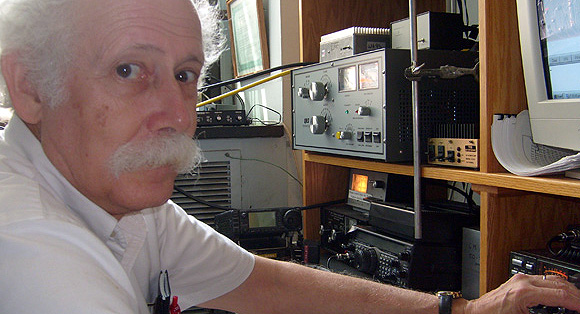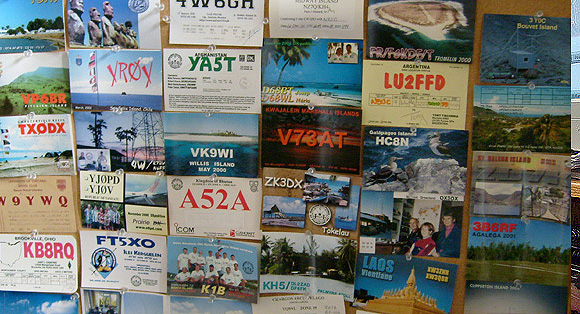| Sun | Mon | Tue | Wed | Thu | Fri | Sat |
|---|---|---|---|---|---|---|
| 1 | 2 | 3 | 4 | 5 | ||
| 6 | 7 | 8 | 9 | 10 | 11 | 12 |
| 13 | 14 | 15 | 16 | 17 | 18 | 19 |
| 20 | 21 | 22 | 23 | 24 | 25 | 26 |
| 27 | 28 | 29 | 30 | 31 |
CATEGORIES
RECENT ENTRIES
BLOG ROLL
On the air
Or, .-. --- ... -. . .-. .----. ... .-. .- -.. .. --- .-. . -.. --- ..- -... -
 “There’s a radio teletype station on in the Persian Gulf,” observes Jonathan Rosner, the professor of physics who’s showing me around the oversized closet in the Research Institutes (RI) building that houses the University of Chicago Amateur Radio Society office. “Let’s see if we can decode something.” A computer translates a bewildering series of beeps into an equally bewildering string of characters. Rosner points out a few of the relevant details: an operator with call sign W3CC is calling a station from Oman, A41OO. Another American operator, KK5OQ, joins in.
“There’s a radio teletype station on in the Persian Gulf,” observes Jonathan Rosner, the professor of physics who’s showing me around the oversized closet in the Research Institutes (RI) building that houses the University of Chicago Amateur Radio Society office. “Let’s see if we can decode something.” A computer translates a bewildering series of beeps into an equally bewildering string of characters. Rosner points out a few of the relevant details: an operator with call sign W3CC is calling a station from Oman, A41OO. Another American operator, KK5OQ, joins in.
This is the world of amateur radio, where hobbyists transmit radio signals of every conceivable variety—Morse code, teletype, voice signals, even television—to each other around the globe. In a world where the Internet has made Dakar as easy to contact as Dayton, the appeal isn’t just the ability to communicate. Amateurs—or hams, as they’re often dubbed—enjoy the challenge of finding just the right frequency and weather conditions to make contact with strangers in another state, or on another continent. Getting a license isn't hard; just pass a written test and pay a small testing fee, and the FCC will give you a call sign. (Having earned my license just last month, I can say that anyone can do it, though it does help to know some physics; by coincidence, Rosner was one of my physics professors in college.)
Rosner has been a radio ham since he earned his first license in 1953 when he was 11 years old. Using the antennas atop the RI, he’s contacted other hams operating as far away as Estonia—by bouncing a signal off the moon's surface—and as close as Ryerson Labs on the main quadrangles. In 1993 he used the amateur radio bands to establish a communications link with University astronomers in Antarctica.
Over the past two decades, Rosner’s been part of the University of Chicago Amateur Radio Society. The club, though intermittently dormant, has a long provenance—it was ejected from its original location in Eckhart Hall to provide space for the Manhattan Project. Today, though, you can count its members on one hand.
Rosner takes me up to the roof, where the club’s antennas are mounted. Incredibly, there are 11 of them up there, each designed to take advantage of a different wavelength. “Well, that’s all going to end,” he says matter-of-factly. The RI is slated to be emptied this year and demolished the next, to make way for the new William Eckhardt Research Center. In the meantime, the radios will be moving across the street to a temporary office in the Kersten Physics Teaching Center. The quarters will be even tighter, access to the office will be more restricted by building hours, and the loss of some of the antennas means giving up transmitting on certain frequencies.
So if you happen to be listening to the amateur radio frequencies, keep an ear open for Rosner, who might be using his own call sign of WO9S or the club’s call sign, N9UC. And if you hear a tentative transmission from a KC9STH, that’ll be me, trying out my new radio license.

Benjamin Recchie, AB’03
July 30, 2010
